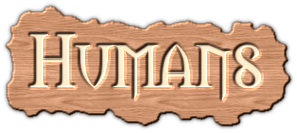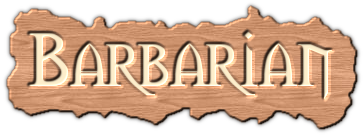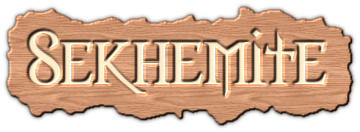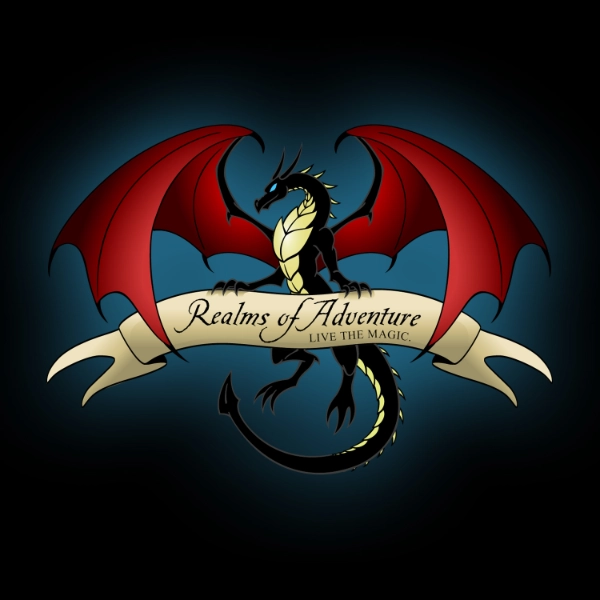[sta_anchor id=”humans-top”]

Al’Hazirian – Amazon – Barbarian – Highlander – Ipponese – Shavali – Sekhemite – Solinarian – Twin Kingdoms
Humans are by far the most numerous and prolific race in the world. Their tendency to have several offspring and urge to settle new areas has helped them to become so widespread. Elven scholars theorize that since Humans are among the shortest lived; they possess a sense of their own mortality more keenly then do other races. For this reason they take risks and seek fulfillment where other races do not. The land is dotted with small villages, towns and even a few large cities inhabited primarily by Humans. Humanity tends to be dependent on close social groupings for mutual protection and trade. Different civilizations complete with systems of government and social customs are found throughout the land. Players may choose from the civilizations listed below or may develop concepts in conjunction with staff. As with all races, Humans are a diverse lot and these options present a guideline to assist the player in developing his/her background. On the map there are vast spaces intentionally left blank to allow players to develop their own unique concepts and smaller civilizations.

Humans of the Twin Kingdoms are the most common of any Human culture. The kingdom is centrally located and spreads across the land and encompasses many different geographical areas and climates. It should be noted that the Twin Kingdoms is united under one centralized government but is made up of two formerly separate, autonomous lands, Vondara and Breckendorf. Vondara is the traditional kingdom of the Guari Elves, and Breckendorf the seat of the first Humans who the Guari came in contact with. After prospering alongside each other for centuries, intermarriage and cooperation became fairly commonplace and eventually the two united under one banner. Today the ruling family is primarily made up of Half-Elves and the population of the kingdom, though mostly Human, represents a large number of Guari Elves and Half-Elves. Additionally, due to its liberal policies towards strangers and central location, representatives of nearly every civilized race can be found there. The Humans are very much like Humans of our own medieval and renaissance periods. The society is feudal but criminals are typically given a fair trial and the ability to seek representation. A knight judge or local lord is typically the individual that determines the penalty for the guilty. People from all civilizations and walks of life pass through on a daily basis, offering many opportunities for adventure as well as commerce.
The Twin Kingdoms was recently embroiled in the throes of civil war. The citizens of New Calendale cast their allegiance with Queen Nehemiah, the daughter of the late Queen Calithandra. Meanwhile other parts of the kingdom had pledged support to Duke Allector Tallen, a powerful noble. Tallen and his supporters claimed Nehemiah was an imposter, believing she actually died years ago, and they have proclaimed Tallen king. As more evidence surfaced, it became known that Tallen masterminded the assassination of Queen Calithandra, in his bid to take the throne. This led to more and more people joining Nehemiah’s side resulting in her eventual victory and coronation. The terrible war was not without its price however, leaving death and destruction in its wake. The opportunities for advancement, fame and wealth are ripe as commoners are enlisted to patrol the kingdom’s borders, fend off monsters and bandits, and help with the reconstruction efforts.
Citizens of the Twin Kingdoms are a diverse lot, and nearly all professions are open to them. The only exception to this rule is the path of the shaman which is viewed as uncivilized and backwater. In these years following the Third Goblinoid and Civil wars, the frontier and smaller outlying settlements are in constant danger from the rampaging hordes as well as opportunistic monsters, bandits and unspeakable menaces.
• Notes: The Twin Kingdoms house residents of all the known races. The society is very much like the one of Medieval – Renaissance Europe. Costuming for a character from this area is fairly easy, with most medieval or renaissance garb being acceptable. If you are playing a race other than Human, make certain to check those requirements as well.
• Advantages – Health +2 OR Casting Resource +2
• Classes Available – Bard, Cleric, Fighter, Mage, Merchant-Artisan, Monk, Rogue, Scholar
You may view or download the Twin Kingdoms Human racial packet here.
[sta_anchor id=”humans-al’hazirin”]

The land of Al’Hazir is a dry, desolate and unforgiving one. The race of men that lives here is one primarily brought up on hardship and taught to take nothing for granted. Living alongside the Kelonians, many Al’Hazirins have a very similar lifestyle, of semi-nomadic tribes of people seeking fresh sources of food and water as well as shelter from frequent sandstorms. Still this exterior view of this noble people hides pockets of civilization where huge towns and small cities can be found adjacent to the sea coasts. Here, the people thrive in huge bazaars and marketplaces with all the hustle and bustle of any civilized place in the world. Goods from all over the world are bought and sold here, some of questionable origin and legality. Merchants arrive daily from distant ports sometimes carrying cargo as simple as sealed casks of water whose price can fluctuate as high as any other valuable commodity.
The people of Al’Hazir are a varied lot. Some of the noblest souls and most self-serving individuals call this place home. Brave and noble people dedicate their lives to the survival of the people as a whole. At the same time thieves and murderers prey upon foreign merchants and visitors. The land is ruled over by a sultan and his word is law. The cost of breaking the law in Al’Hazir is extreme, with public humiliation and mutilation (such as the removal of the hand of a thief) being fairly common, but despite this Al’Hazir’s cities can be as dangerous as the desert that surrounds them.
People from Al’Hazir often wear light-colored, loose-fitting garments. The style is very much like a layered robe with an emphasis on comfort. The light colors and material helps them to survive the blistering heat of their homeland and keeps sand out for the most part. Al’Hazirins can be found nearly anywhere in the world as traders and travelers.
• Notes: Al’Hazir is a land representative of the Middle East. The people, customs and dress are as varied as the countries of the Middle East, and these should be used as a guide. Additionally, the people are interchangeably known as “Al’Hazirins” and “Al’Hazirians.”
• Advantages – Health +2 OR Casting Resource +2
You may view or download the Al’Hazirin racial packet here.
[sta_anchor id=”humans-amazon”]

Amazons are a race of warrior women originating in the island kingdom of Rythos. These women are highly intelligent and take great pride in their abilities. The legends tell of the time of the creation of all humanity that the god who had the biggest hand in the creation of the Amazons was Mhizrak, god of war. To this day the Amazons identify most strongly with Mhizrak as their patron and there is a large sisterhood of these women warriors known as the “Daughters of Mhizrak” who are renowned for their combat prowess, functioning as mercenaries from time to time. A large company of these women in fact has been engaged in battle with the Goblinoids for some time, being among the first forces to mobilize to meet them. Amazons study not only the use of weapons but the strategy and tactics of war as well. The most apparent and obvious class choice for most of these women is fighter, followed closely by cleric (usually of Mhizrak). There are also a fair number of mages in their ranks. Since Amazons maintain their own groups and orders they do not become monks and scholars in the traditional sense, and these are often seen as weak. Lastly Amazons deplore thievery and treachery in all its forms and will never consider the path of rogue. They are a highly moral civilization, sometimes to the point of being naïve.
Amazons are highly civilized and cultured and although their kingdom is small it is thriving. There is a great sense of unity and cooperation that is not often found elsewhere. In warfare these women can be ferocious fighters, but they wage war with discipline and honor. Surrender will always be accepted (although a previously treacherous foe may not get the option), and they do not commit some of the savage acts other armies do such as razing the land, burning towns or eradicating civilian populations. Some say this is due to Attalia’s influence.
Although all PC Amazons MUST be female, there are in fact male members of their civilization. These men are almost never seen outside of Amazon civilization and even when they are they are quiet and subservient. It should be noted however that they are not exactly slaves. Amazon society exists as a type of rigid caste system, where men perform many of the tasks other civilizations delegate to women.
• Notes: Amazons must be female and come from a female dominated society. That being said it is important to note that this does not necessarily make them hate or even look down on men when outside their society. They do regard the men in their homeland as second class citizens however.
• Advantages – Health +2 OR Casting Resource +2
• Classes Available – Cleric, Fighter, Mage
You may view or download the Amazon racial packet here.
< Back to top >
[sta_anchor id=”humans-barbarian”]

Barbarians are a race of fierce tribes-people living in the Northern tundra and frozen wastes of Adraveth. Barbarians are somewhat primitive by most standards, loud and aggressive, lacking social etiquette and graces found in some of the other human cultures. Barbarians often dress in furs and animal skins and occasionally rough-hewn clothing. Many tribes subsist mainly on hunting and foraging but a few do augment their diets by farming. Settlements of these people range from natural caves and tee-pee like structures all the way up to small but efficient villages made of earth and stone. Although most of these people never leave the shelter and support of their tribe, some will go and seek their destiny in the “lands beyond” which is how they refer to the world outside their frigid homeland. There are many tribes of these people and customs do vary slightly from one tribe to the next. Sometimes tribes will have brief wars or rivalries but tend to share in common certain bonds that draw them to one another when found as strangers in more civilized lands.
Barbarians tend to be strong of body and will. The harsh conditions of their homeland make them shrug off many hardships other Humans would find unbearable. Barbarians tend to be very direct in their approach to problem solving and do not generally appreciate subtlety. Barbarians see reading and writing as a waste of time and counter to their strong beliefs in oral tradition, where stories and learning are passed down from generation to generation. This does not make them stupid, they just value learning gained through wisdom and experience over that which is gained through books. Barbarians are a close-knit people with strict family values and great respect for their elders. As a rule, barbarians are a very suspicious and superstitious people. Outsiders are often viewed with mistrust and this is not easily changed. Most “modern” things frighten or confuse them. Magic is regarded with extreme aversion at best and provokes attacks on the caster at worst! The only magic barbarians will willingly allow cast upon them is shamanic magic. They will also use alchemy willingly as they see it as a gift of nature. Barbarian characters should react VERY negatively if magic is used on you (Even if it is beneficial!) or in your presence by a mage, although this does not automatically mean you will attack. It is up to you to decide how to role-play this but it must be role-played. Clerical magic is seen as taboo and although they will not react as negatively towards its use as they do with magery, it will upset them, and they will most often ask that clerical magic not be used upon them.
• Notes: Barbarians can be a fun but challenging race to play. Your character need not be stupid, but should lack formal education as such is not available in his/her culture. Costuming should be rough, with leather garments, furs, and hides helping to keep most in character. Metal armor should be avoided unless there is a good explanation for your character to have it. Many Barbarians will also decorate their faces with war paint or other makeup to appear fiercer. Try to avoid using blue where possible so as to not be mistaken for a Highlander. Additionally on magic, as stated above, Barbarians dislike ALL magic except shamanic. Arcane magics frighten them and may provoke them to attack, keep this in mind when creating your PC. Additionally Barbarians are not literate and will shy away from learning to read and write.
• Advantages – Health +2 OR Casting Resource +2
< Back to top >
[sta_anchor id=”humans-highlander”]

As the name would suggest, these people hail from the rolling green highlands north of the Twin Kingdoms. To most civilized folk, Highlanders are just a small notch up from Barbarians – crude, uncouth and lacking social skills. Highlanders are in fact a strong, proud, fiercely independent group whose brave deeds and noble acts are the stuff of legends. Highlanders organize themselves into clans made up of many extended families. Highlanders wear kilts and tartans reflecting the color and sometimes stature of their clan. Clansmen stick together and an insult against one is an insult against all. They will not hesitate to fight to defend their honor or that of a woman, and are generally fairly chivalrous.
Highlanders farm, raise sheep and cattle, and are generally self-sufficient, training their own smiths, wrights and other tradesman. A fairly simple, peaceful people Highlanders enjoy good company, good music and especially good ale. Buy a Highlander an ale in the tavern and he may tell you a tale; buy him two and you may be on your way to making a life-long friend. Highlanders can be seen in the streets of the Twin Kingdoms where they come to trade and sometimes hire themselves out as mercenaries and bodyguards. In recent years Highlanders have become a more common sight in towns and cities as they join up with traveling armies fighting the Goblinoids.
• Notes: For playing Highlanders, inspiration can be drawn from many sources but primarily think of the ancient Scots and in some cases the Irish. Kilts and tartans are not optional, although blue “woad” war paint is. Additionally Highlanders should at least attempt a Scottish (or Irish) accent. A great source of ideas and accents is the movie Braveheart with Mel Gibson.
• Advantages – Health +2 OR Casting Resource +2
• Classes Available – Bard, Cleric, Fighter, Merchant-Artisan, Rogue
< Back to top >
[sta_anchor id=”humans-ipponese”]

Far to the east, at the very edge of the world, is the small continent of Ippon. It is a land and culture shrouded in mystery, with strange ways and customs. Since it is on a separate continent, Ippon developed independent of the other human cultures, accounting for many of the differences. Interestingly other races such as Elves, Dwarves and Fae have lived there for as long as anyone can remember, and some others have moved there in the past several centuries. The continent has traditionally been ruled by different dynasties for thousands of years. The current ruling dynasty, the Sho-Hong, have been in power for nearly 300 years. The “Esteemed Emperor of the Sun” Hikaru Sho-Hong, has personally overseen the empire for the last 33 years, since he was 12 years old (although it is said his constables and advisers did much of the actual ruling and he was initially a figurehead). The empire is a prosperous one, family oriented and a popular destination for traders from far-away lands. All manner of exotic goods can be found in Ippon and although the trip is a long one, a successful voyage can be extremely profitable.
In the cities and towns the people live in relative safety and harmony. Of course there are law-breakers, but these tend to be dealt with swiftly and sternly. Outside of the settlements there are great expanses of wilderness and unsettled territory. All manner of monsters, humanoids, and bandits can be found prowling for unsuspecting travelers. The land has been largely untouched by the Goblinoid wars with much of the fighting taking place on the main continent. Despite this many people from Ippon have found their way to the main continent as mercenaries and soldiers helping the other civilizations. It is theorized that if these lands are allowed to fall, the Goblinoids will surely attempt to invade Ippon. One problem the empire has had of late has been the mobilization of warlords challenging the empire from without and within.
Most professions are open to people from Ippon, and all are seen to have their place and value. Racial tolerance is widely practiced in Ippon and while walking the streets of the larger settlements, especially their capital city, Shotokai, a multitude of different races can be seen – many perfectly assimilated into Ipponese culture.
• Notes: Ippon is based on a blending of various Asian cultures. The two figuring most prominently are ancient Chinese and Japanese with influxes of various other cultures. Clothing and style is very reflective of traditional Asian dress. There are many sources of information that can be drawn upon for inspiration both in books and on the internet.
• Advantages – Health +2 OR Casting Resource +2
• Classes Available –Bard, Cleric, Fighter, Mage, Merchant-Artisan, Monk, Rogue, Scholar
You may view or download the Ipponese racial packet here.
< Back to top >
[sta_anchor id=”humans-Shavali”]
SHAVALI
Shavali are a race of people known in all lands, for they are given to wandering from one end of Adraveth to the other and then back again. Often regarded as vagabonds, liars and thieves they do not always receive a warm welcome as they travel. Many times however Shavali are a welcome sight as excitement and merriment seems to follow wherever they go. Shavali love to drink, tell stories, sing, dance and entertain the masses. When Shavali are nearby people often seek the entertainment they provide, but keep their coin purses close and their children closer. Shavali make their living by begging for coins, working odd jobs, repairing items (tinkers), adventuring and entertaining – some even run circuses or acrobatic troupes. Additionally since they travel far and wide and hear many stories, they are often an excellent source of information. Shavali dress in colorful, garish, usually clashing outfits and adorn themselves with all manner of jewelry, beads and bells.
Beneath the jovial, fun-loving exterior is a serious quality and if provoked, a searing anger. Shavali tend to be good folk but are among the worst enemies one could have. If Shavali feel they were wronged, cheated or seriously insulted one can often count on retribution. Most often a slight against one is seen as a slight against all, and if the charge is serious enough a person might find him or herself in quite a predicament! On the other hand a true friend to the Shavali can always count on them.
• Notes: Shavali can be great fun to play, but can be difficult as well. It is a secretive society, with many rules and restrictions. As far costuming, generally the louder the better. Bright colors and clashing outfits are the norm. Also consider some jewelry (This can be non-stealable prop jewelry solely for character enhancement), such as earrings (males and females) bracelets, chains etc. If it jingles it’s that much better! Lastly you must at least attempt an accent, Romanian preferred.
• Advantages – Health +2 OR Casting Resource +2
* Note – Shavali are a rare race of people that if they were to cluster in large numbers in a particular area they would doubtless be run out of town. Additionally it is a very challenging race to portray accurately. For these reasons it is restricted race and requires staff approval before creating a Shavali character. Generally speaking, new players will not be permitted to create Shavali characters. A character background 2 weeks prior to play is mandatory, and we may decline anyone at any time for any reason. They may become capped at any time. If a cap in place it will be noted here and/or on the message boards as an announcement. You may check the status at any time by emailing staff. Please email staff with any questions.
[sta_anchor id=”humans-sekhemite”]

To the Southeast of the Twin Kingdoms lies the sprawling civilization of Sekhem. Her people were already ancient when the humans of Breckendorf were still uncivilized tribesmen. The majority of the kingdom is covered in sandy desert, devoid of almost all life. In the north of the country is Lake Khameseneb, fed from waterfalls in the Dragonspine Mountains. Rushing from the lake is the River Ahkeshep. Around this lake and river is a thriving civilization with two huge metropolises and several smaller cities. Some distance west from the capitol is what is called the “Necropolis,” or city of the dead. Five mammoth pyramids, tombs of kings of the past, surrounded by smaller ones and various mausoleums and tombs lie in this valley as far as the eye can see. Most often this area is eerily silent, but various guardians lurk in the area, ready to defend the final resting places of their masters.
Sekhem has always been shielded from outside influence and invasion by its location, surrounded by ocean, mountains and desert. In recent centuries however, trade routes have opened up across the sea to Sekhem. With this influx of trade has come the diffusion of ideas and products from different lands. Sekhemites are extremely protective of their territory and somewhat stand-offish towards other Human civilizations and other races. They are fascinated by Kelonians and see them as lucky to be around. This stems mostly from the fact that Sekhemites revere cats as messengers of the gods and Kelonians are so cat-like. Sekhemites are suspicious of Agorians due to a war that lasted nearly 50 years. Agorian scholars began invading the tombs of the Sekhemites in the necropolis and were met with brutal retaliation. The war has been over for 18 years but the Sekhemites have never gotten over it. Sekhem trades regularly with the kingdoms of the Dwarves and Al’Hazir. In the kingdom one can frequently see a Kelonian, sometimes see an Elf, Dwarf, Agorian or other Human, and rarely see any other races.
Sekhemites as a whole are very religious and clerics are seen as the noblest of professions, followed closely by mages and scholars. A fair number of able fighters and rogues also exist. There are also some Sekhemites found in monastic orders.
• Notes: Sekhem is based loosely on Ancient Egypt. Styles of dress and adornment are often similar to Al’Hazir but can also be more traditional in style.
• Advantages – Health +2 OR Casting Resource +2
• Classes Available – Cleric, Fighter, Mage, Merchant-Artisan, Monk, Rogue, Scholar
You may view or download the Sekhemite racial packet here.
< Back to top >
[sta_anchor id=”humans-solinarian”]

Immediately to the west of the Twin Kingdoms lies the empire of Solinaria. Ruled by an emperor said to be insane, who claims divine right of the gods, Solinaria is highly cultured yet expansionist, militaristic and very territorial. Relations between Solinaria and the Twin Kingdoms have gone through various extremes throughout the years. Solinaria began as a fairly small kingdom with limited representation from the people. Over time they have blossomed to nearly 10 times their original size, conquering local provinces and subjugating more primitive inhabitants and smaller civilizations. Several small wars and skirmishes were fought between the Twin Kingdoms and Solinaria, causing the Twin Kingdoms to cede some of its territory in a bid for peace. For the past several decades relations have been cool but peaceful. With the onset of the third Goblinoid war, Solinaria remained in perhaps the best military situation to confront the menace and thus have become allies with most of the other civilizations. Solinarians are often seen as arrogant, self-serving and overly aggressive by the other races and human peoples, but their military might is unquestionable and their cultural advances enviable.
Although the empire of Solinaria is often seen by others in a somewhat negative light, her people are not very much different than the typical Human of the Twin Kingdoms, although with a better standard of living. Often Solinarians do have something of an air of superiority about them, but otherwise get along well with others. Other people do most often have difficulty separating an individual Solinarian from the empire he comes from, but they are tolerated in most places, if not completely accepted. Solinarians tend to be well rounded people, highly educated by the standards of most Humans, and multi-talented. Current and former members of the Solinarian legions are respected and often feared as deadly warriors. The Solinarian Academy of War, dedicated to Mhizrak is the most respected place to learn the ways of combat in the world. Solinaria is also home to other prestigious organizations such as The Crimson Fist (a monastic order).
• Notes: Solinaria is very much like Ancient Rome during the Roman Empire, after the emperors took full control of the republic. There is a multitude of material and movies, such as Gladiator, which can be used to help get the creative process sparked for your character concept and costuming.
• Advantages – Health +2 OR Casting Resource +2
